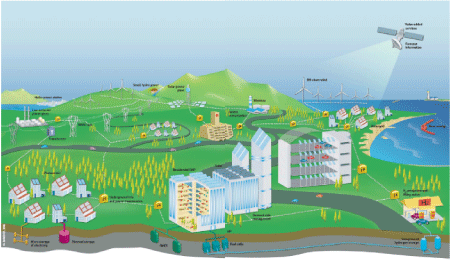 My last post made the points that:
My last post made the points that:
- Long-distance transmission lines tying different climate zones together reduce storage needs to a few hours capacity, by ensuring that most of the time when one machine is not producing, another is.
- The least expensive and most ecologically sound way to store electricity on the particular scale needed is with closed-cycle, lined, modular pumped storage that recirculates the same water over and over again, and thus does not draw on rivers, lakes, or other natural watercourses.
However a grid must not only be able to meet baseload (the part of demand that is the same 24 hours a day) plus daily peaks. It also has to deal with seasonal peaks as well. After all, in cooling climates (say Houston) electric demand will peak at a much higher rate in the summer than the winter. Similarly in a heating climate (say New England, Toronto, or Glasgow), demand will peak much more in the winter than the summer.
The same extended grid that can help smooth out supply can also help smooth out demand. If we have a grid that extends 3,000-5,000 kilometers across multiple climate zones, you can connect heating and cooling climates so that summer and winter peaks vary less.
Although low-temperature demand is not responsible for all the variation between peak and baseload, it is responsible for a great deal of it. Since low-temperature heat can be stored much less expensively than either electricity or high-temperature heat, various types of daily and annual heat and cold storage can reduce variations in electric demand.
One of the most obvious and widely used techniques is production of ice at night in office and commercial buildings for daytime cooling. Similarly a new building can incorporate thermal mass, and an existing building can add tiles with phase-change materials to store heat. Phase-change materials could also help incorporate seasonal thermal storage in existing buildings, because they can fit a great deal of low temperature heat or cold in a smaller area. Another variation a reader pointed out to me was storing cold for refrigerated warehouses.
(Another trick in plants that use compressed air might be to produce and store enough during off-peak periods to avoid running compressors during peak periods. The problem with this is probably that the capital costs of oversizing the compressors and tanks to that extent would cost more than the savings gained from reduced energy consumption.)
Then there is efficiency, conservation, and solar climate control and water heating. Generally efficiency and conservation within buildings tend to have faster paybacks in low-temperature application than in other applications. There are exceptions. CFL bulbs have extremely fast paybacks, and more efficient appliances do mostly pay for themselves. It is simply that climate control and hot water tends to pay for itself faster; so as a side effect, efficiency increases will tend to reduce variations between base and peak demand. Similarly solar heating and cooling obviously reduces demand where variation tends be the greatest — in low-temperature uses that change with time of day and season.
Lastly, there is the question of electric vehicles. This is an area where smart grid management can play a serious role. We have discussed Vehicle to Grid applications on this blog before. Using spare capacity in the batteries from electric cars and plug-in hybrid electric vehicles to provide small amounts, grid storage undoubtedly has some value (though not, I think, the amount that it is sometimes hyped to have). But I think smart management will be more important, making sure that such vehicles are charged almost entirely off peak. EV and PHEV cars charged off peak can greatly even out time of day variation in demand; this demand management will play a much greater role in stabilizing a next-generation grid than any storage they provide.
To manage all this will require a “smart grid” — a digital computerized grid that can respond to decentralized generation and storage, and which will also manage demand from certain kinds of consumer and commercial appliances: some consumers — and commercial and even industrial customers — will sell this right to utilities in return for reduced power bills. I won’t go into detail on this because it looks like a number of new posters, including Patrick Mazza, will explain this in depth.
Very roughly, in today’s grid baseload is about 40 percent of total kWh consumed. I think the combination of an extended grid with the demand management means described can conservatively increase that to 60 percent (possibly a great deal more), and may reduce seasonal differences in demand substantially as well.
What about any seasonal differences that remain? This can be managed, to a large extent, on the supply side. Different wind areas have differing seasonal peaks, with very few in summer. Solar electricity, whether obtained from rooftops or desert arrays, will always peak in the summer. So basically by placing a higher percent of your capacity in solar electricity, you can make sure your national grid’s production peaks in the summer; alternatively, by building more of your capacity as wind, you can make sure that it peaks in the winter. In general, if you manage your demand curve, you can put together a supply curve that will match.
Of course this is not something that is easy to do with a deregulated grid. There is a reason standard economics describes electricity as a public good. The kind of whole-system, long-term thinking this kind of thing involves really is easier with publicly owned power companies, or at least tightly regulated monopolies.
 My last post made the points that:
My last post made the points that:
